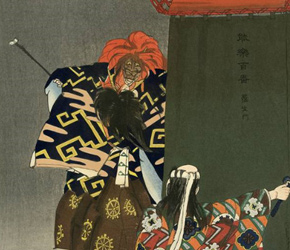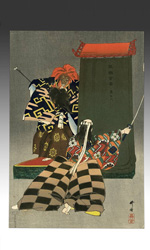Kogyo and Noh Drama Prints
 |
|
Although many
 |
|
More than any other Ukiyo-e artist, Kogyo Tsukioka produced woodblock prints considered to be perfect reflections of Noh drama. Kogyo prints show an actor or a group of actors against a plain background, sometimes with one or two requisites. A typical print by the artist looks more like an ink drawing, painting or watercolor than a classical Ukiyo-e print. Although he created a number of woodcuts dealing with natural history and contemporary events (such as the Russo-Japanese War), his name will always be associated with Noh drama woodcuts he designed for the publisher Heikichi from1897 to 1926.
Tsukioka
Kogyo was also considered a technical innovator of woodblock printing. Concentrating upon the elaborate costumes of the Noh theatre, many of his woodcuts utilized silver and gold inks, overlays of mica grounds, and blind-stamping, a method where a raised design is impressed into the paper. The prints Kogyo created provide one of the richest veins of historical and artistic information about Noh drama available today. They are widely considered veritable tours-de-force of late nineteenth and early twentieth century Ukiyo-e.
Download this Article: Kogyo and Noh Drama Prints.pdf